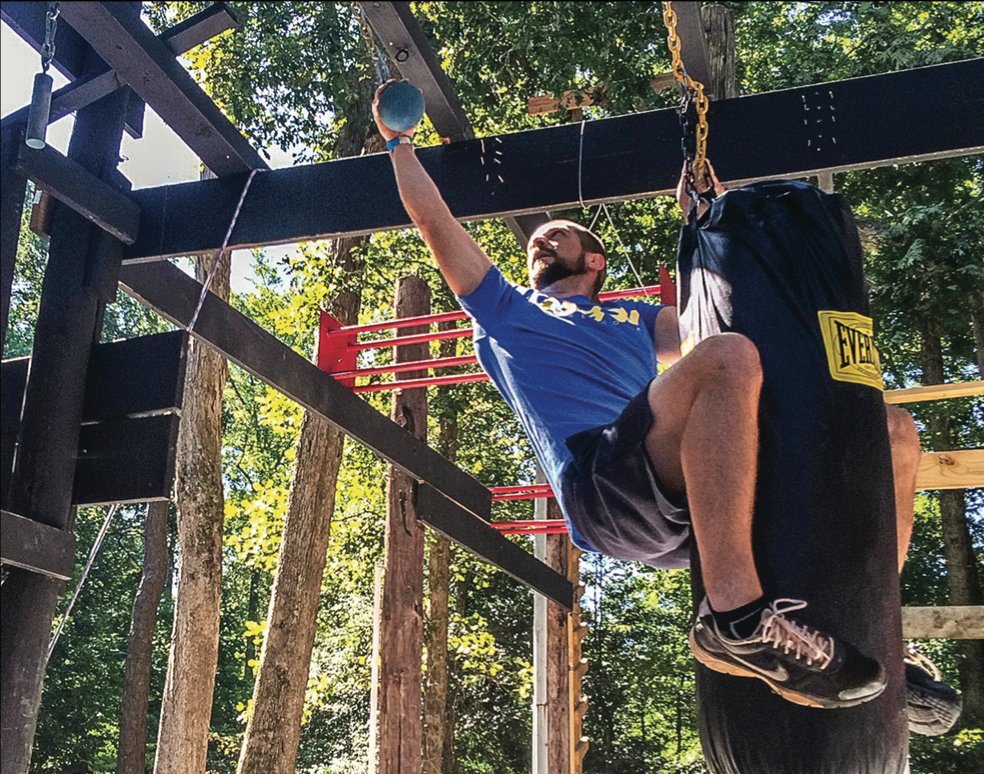Liberty theology professor works to secure spot on American Ninja Warrior
“In February or March, hopefully (my) phone will ring and I’ll see a California area code and it’ll be the folks from Ninja Warrior,” Dr. Chad Thornhill, a theology professor at Liberty University, said with a smile while discussing his most recent hobby.
After seven years of rigorously pursuing a Ph.D. and having little time to workout, Thornhill decided to strive for a new goal outside of the realm of academia. This January marks the third year he has applied for NBC’s obstacle course competition, “America Ninja Warrior.”
When he’s not teaching theology at Liberty, he enjoys figuring out new ways to obtain a spot to compete on the show, whether through training or building obstacles of his own.
Thornhill said that he finds training for this show to be a great mental release from the stresses of everyday life.
“It’s a fun way to stay in shape — better than lifting weights or (running on) the treadmill,” Thornhill said. “(Since) you’re using your mind, it’s a creative way to exercise.”

TRAINING — Thornhill has built a training area around his house to practice more often. Photo Provided.
He primarily trains using body weight exercises, such as push-ups, planks or pull-ups. Since a majority of the competition’s course is based on upper-body strength, the type of training has been different than what he has done before through organized sports. At least three times a week, Thornhill is training at LaHaye’s rock wall, as bouldering has proved one of the most useful forms of training.
“(Climbing) builds hand and finger muscles unlike any other exercises,”Thornhill said.
Not only does he physically train, but he practices mentally through his own course creation.
“(I’ve) built stuff around the house, much to my wife’s chagrin,” he said.
Thornhill first decided to apply three years ago. He filled out the 7-8 page application, submitted a video that told his story and displayed his athletic capabilities. Then, he waited.
Though nothing happened, he decided to take it more seriously the second time around, and trained more intensely. This time his application made it past the first round with the casting company, yet he didn’t make the cut for the second round with the production company.
When only 600-700 individuals are chosen out of the 80,000 applicants, it is hard to stand out. Thornhill said he hopes that being a theology professor who wants to take on the challenge will put the odds a bit more in his favor.
Though he did not participate in the competition last year, through an underground social media group of Ninja Warriors, he found out about open calls to be a course tester. In order to make the courses evenly difficult and possible to accomplish, testers are needed to perfect the obstacles. Last year, Thornhill briefly tasted the excitement by testing the course in Atlanta and staying for the taping.
“The only drawback to being a tester is that it disqualifies you from participating for the rest of the year,” Thornhill said.
If an individual’s application does not go through, being a tester is not the only way to hit the course. If early and patient enough, individuals can stand in line as walk-ons at qualifier locations. According to Thornhill, last year in Atlanta, lines began three weeks prior to the show’s taping.
This started as a Japanese show called “Sasuke,” where American participants were sent to compete in Japan to compete on difficult obstacle courses and race each other for the fastest completion time. The show slowly morphed into the Americanized version of the show as it exists today. Originally, Ninja Warriors were the few who survived a pre-requisite boot camp before arriving in Japan, yet by the fourth season, it was brought to the U.S. and named American Ninja Warrior, with finals held in Las Vegas.
The decision to move the show proved worthwhile, as devoted fans have spread throughout various states. According to Thornhill, this particular community and hyped excitement about the show is something that sets it apart,
“You don’t compete against each other,” Thornhill said. “It’s all of the Ninjas against the course — everyone is rooting for each other to succeed. … Part of it is for the experience, and the other part is to see how far I can push myself.”
That being said, Thornhill’s main goal is to make it through the city qualifying round, understanding that there are other contestants stronger and fitter than himself. Only time will tell, but updates on Thornhill’s progress can be found at his Twitter @ChadThornhill.
Palumbo is a feature reporter.